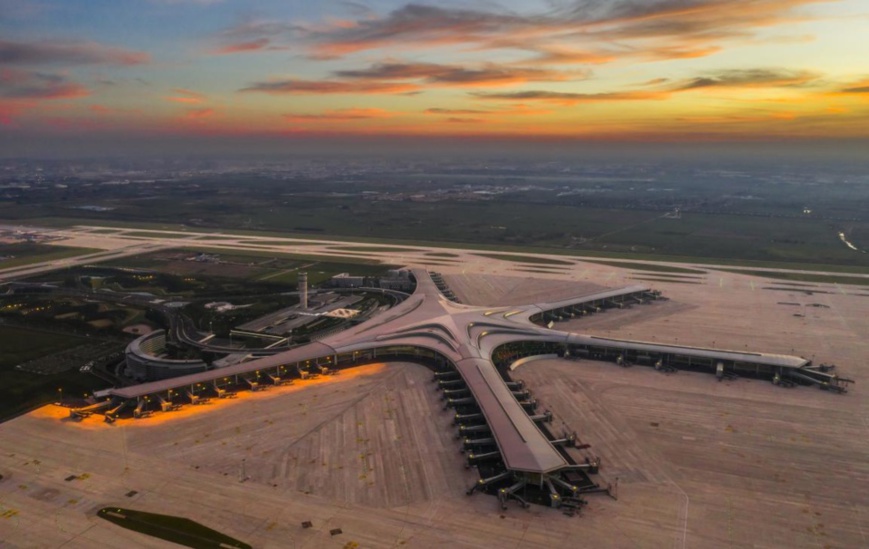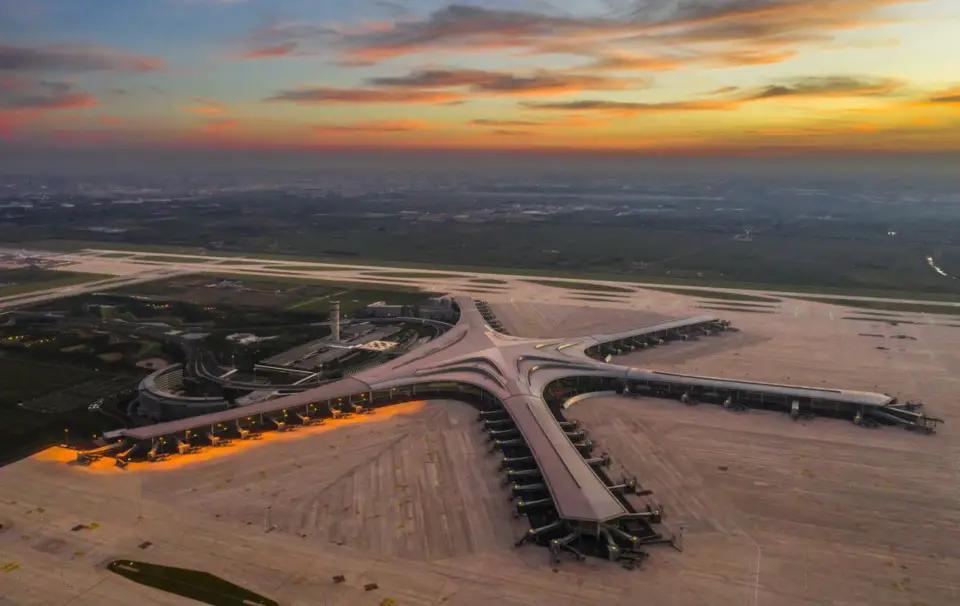By Qiu Chaoyi, People’s Daily

A bird’s-eye view of Qingdao Jiaodong International Airport in east China’s Shandong province. (Photo by Wang Hua/People’s Daily Online)
China is accelerating the building of a modern airport system that features a good layout and complete functions by transforming and expanding hub airports and building small and medium airports in remote areas.
During the first half of this year, fixed-asset investment in China’s civil aviation industry amounted to 43.5 billion yuan ($6.72 billion), an increase of 8.5 percent year on year. By the end of June, 23 airports were under construction in the country.
Some newly-built airports made their maiden flights during the first six months of the year. On June 27, an aircraft of Sichuan Airlines left Chengdu Tianfu International Airport, a 4F-class airport situated in Chengdu city, southwest China’s Sichuan province, with 262 passengers. It was the first commercial flight of the airport after it was officially put into operation.
During the same period, the country also made progress in the construction of some airports. For example, Ezhou Huahu Airport, an airport under construction near Duwan village, Yanji township, Ezhou city, central China’s Hubei province, is changing with each passing day as over 6,000 constructors work around the clock amid busy cranes and roaring concrete delivery trucks.
Ezhou Huahu Airport is the first professional cargo airport in Asia, said Zhang Gan, head of the planning and development department of Hubei International Logistics Airport Co., Ltd. After it is put into operation, the airport will achieve an annual cargo and mail throughput of more than two million tons, Zhang added.
Besides newly-built airports, airline hub transformation and expansion projects also represented a large proportion of the investment in civil aviation industry from January to June.
According to Han Jun, an official with the Civil Aviation Administration of China, 40 of the 50 busiest airports in China will undergo reconstruction and expansion.
Many airline hubs haven’t been able to satisfy the demands of rapidly growing air passenger traffic in recent years, which makes it necessary to increase their capacity and improve their comprehensive abilities and services, Han pointed out.
Another highlight of the investment in civil aviation during the first half of this year is the momentum of smart aviation.
As smart aviation construction is continuously advanced, air travelers’ experience has been significantly improved, Han said. This year, 40 airline hubs in China will be covered by Radio Frequency Identification (RFID), an advanced technological means of luggage management in civil aviation industry, according to Han, who explained that if applied in whole-process luggage tracking system, RFID technology ensures faster and more accurate baggage claim than barcode recognition, not only saving passengers’ time, but allowing them to track luggage on their mobile phones.
Airports, which used to be a basic symbol of megacities, are increasingly seen in small towns. Since it began operation in September last year, Ankang Fuqiang Airport, located in Wuli township, Ankang city, keeps setting new records almost every day. In the first six months this year, its passenger throughput reached 132,400, said Ji Yinghui, general manager of the operator of the airport.
Cao Bo, deputy secretary of the commission for discipline inspection at the operator, stressed that the airport has made it easier and faster for local people to travel to other regions, and effectively attracted visitors to the area.
China will put more efforts into building a batch of small and medium airports in central, western and remote areas across the country, like airports under construction in Chenzhou city, central China’s Hunan province, and Zhaosu county, northwest China’s Xinjiang Uygur autonomous region, Han noted.
China plans to build over 30 new airports from 2021 to 2025, mostly in central and western areas of the country, in a bid to continuously extend its airline network and helping more people get access to convenient air traveling services, according to Han.
During the second quarter this year, civil aviation industry saw a sharp rise in passenger traffic from the first three months, while domestic air passenger transport volume basically recovered to pre-COVID-19 levels.
Although China’s passenger traffic ranks second in the world, its civil aviation industry still faces unbalanced and inadequate development.
Considering the fact that the country has a middle-income group made up of over 400 million people and an even larger low- and middle-income group, Han believes that Chinese people’s demands for air transport will continue to grow significantly and that China’s efforts to boost the development of civil aviation come right in time.
During the first half of this year, fixed-asset investment in China’s civil aviation industry amounted to 43.5 billion yuan ($6.72 billion), an increase of 8.5 percent year on year. By the end of June, 23 airports were under construction in the country.
Some newly-built airports made their maiden flights during the first six months of the year. On June 27, an aircraft of Sichuan Airlines left Chengdu Tianfu International Airport, a 4F-class airport situated in Chengdu city, southwest China’s Sichuan province, with 262 passengers. It was the first commercial flight of the airport after it was officially put into operation.
During the same period, the country also made progress in the construction of some airports. For example, Ezhou Huahu Airport, an airport under construction near Duwan village, Yanji township, Ezhou city, central China’s Hubei province, is changing with each passing day as over 6,000 constructors work around the clock amid busy cranes and roaring concrete delivery trucks.
Ezhou Huahu Airport is the first professional cargo airport in Asia, said Zhang Gan, head of the planning and development department of Hubei International Logistics Airport Co., Ltd. After it is put into operation, the airport will achieve an annual cargo and mail throughput of more than two million tons, Zhang added.
Besides newly-built airports, airline hub transformation and expansion projects also represented a large proportion of the investment in civil aviation industry from January to June.
According to Han Jun, an official with the Civil Aviation Administration of China, 40 of the 50 busiest airports in China will undergo reconstruction and expansion.
Many airline hubs haven’t been able to satisfy the demands of rapidly growing air passenger traffic in recent years, which makes it necessary to increase their capacity and improve their comprehensive abilities and services, Han pointed out.
Another highlight of the investment in civil aviation during the first half of this year is the momentum of smart aviation.
As smart aviation construction is continuously advanced, air travelers’ experience has been significantly improved, Han said. This year, 40 airline hubs in China will be covered by Radio Frequency Identification (RFID), an advanced technological means of luggage management in civil aviation industry, according to Han, who explained that if applied in whole-process luggage tracking system, RFID technology ensures faster and more accurate baggage claim than barcode recognition, not only saving passengers’ time, but allowing them to track luggage on their mobile phones.
Airports, which used to be a basic symbol of megacities, are increasingly seen in small towns. Since it began operation in September last year, Ankang Fuqiang Airport, located in Wuli township, Ankang city, keeps setting new records almost every day. In the first six months this year, its passenger throughput reached 132,400, said Ji Yinghui, general manager of the operator of the airport.
Cao Bo, deputy secretary of the commission for discipline inspection at the operator, stressed that the airport has made it easier and faster for local people to travel to other regions, and effectively attracted visitors to the area.
China will put more efforts into building a batch of small and medium airports in central, western and remote areas across the country, like airports under construction in Chenzhou city, central China’s Hunan province, and Zhaosu county, northwest China’s Xinjiang Uygur autonomous region, Han noted.
China plans to build over 30 new airports from 2021 to 2025, mostly in central and western areas of the country, in a bid to continuously extend its airline network and helping more people get access to convenient air traveling services, according to Han.
During the second quarter this year, civil aviation industry saw a sharp rise in passenger traffic from the first three months, while domestic air passenger transport volume basically recovered to pre-COVID-19 levels.
Although China’s passenger traffic ranks second in the world, its civil aviation industry still faces unbalanced and inadequate development.
Considering the fact that the country has a middle-income group made up of over 400 million people and an even larger low- and middle-income group, Han believes that Chinese people’s demands for air transport will continue to grow significantly and that China’s efforts to boost the development of civil aviation come right in time.
 Menu
Menu
 China quickens pace in building modern airport system
China quickens pace in building modern airport system
















